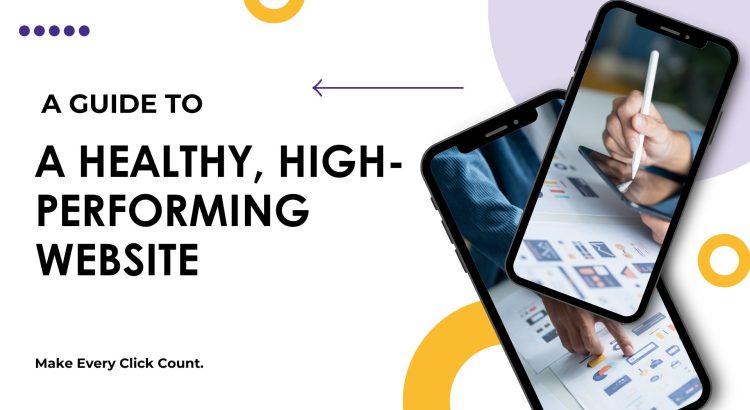A website is itself a business or an online shop that earns not only bread and butter for the owner, but it also establishes it as a brand. Considering its significance, its health is crucial. And for this reason, every website owner should seriously watch out whether it is up and running smoothly. Otherwise, your brand and revenues will take a hit.
Thinking that you’re not like a techie who easily deals with its backend and frontend errors?
Let’s make it easy for you. No! You don’t need to be an experienced developer or high-tech designer for it. Just a few things can simplify understanding the essentials of website design & maintenance, and its security.
Why Website Health Matters More Than You Think
Just think like a website owner- What is your priority? Is it to launch a website only?
Well, you must know that a website is not a one-time project. It needs care and support, as a living being needs. First, understanding that its maintenance is essential, you should learn what it means. A well-maintained website is the one that:
- Loads faster and records bounce rates under 20 or 30.
- Engages and streams visitors through better search engine optimization.
- Is hard to hack.
- Offers a glitch-free journey to online users and continues to boost trust and conversion rates.
- Continues to gain credibility.
Ignoring the health of your website means becoming an easy bait for hackers and losing online business opportunities.

1. Website Maintenance: The Engine That Keeps You Running
So, every website owner should think of these key areas that keep the website updated, seamless, and running smoothly while attracting leads consistently.
Key Areas of Website Maintenance
a. Performance Updates
A website consists of frameworks, CMS, plugins, etc., which need frequent updates. Ignoring them may hamper speedy uploading and show glitches in inquiry forms, bandwidth, etc. Regular updates keep it smoothly functional and speedy.
b. Content Updates
Google continues to track website content, which must be updated as per trends and requirements. For maximizing conversions and developing trust, its EEAT update emphasizes updating banners & blogs, adding case studies, certification, and product pages after checking their accuracy and authenticity.
c. Broken Link and Error Fixes
Visitors dislike broken URLs or web pages, which press them to switch to alternatives. This practice hurts SEO. So, monthly check whether there is any issue that hampers users visits.
d. Backup and Restore Plans
Taking backups of the website is glitch-free if it’s healthy. But any technical faults like accidental deletion of crucial files, or plugin crash can lead to its shutdown. In that case, its backups will help in re-streaming it within a few minutes.
e. Mobile Optimization
Mobile users’ count is in billions, meaning that the website should be mobile-friendly. You must check whether it adapts well to different screen sizes and works smoothly across devices.
2. Website Design and Maintenance: The UI/UX That Matters
A website should be attractive. It’s not only about aesthetic beauty, but its clarity, navigation, and trust. A well-designed website enables visitors to quickly discover and grab deals or act according to call to action. By design, it means the UI or frontend.
Elements of Good Website Design Every Owner Should Know
Let’s check out some elements that indicate your frontend is healthy.
a. Fast Loading Pages
Google has found that visitors decide to switch or stay on the website within 3 seconds. With a clean design and optimized images, you can optimize its speed. It must be clutter-free to ensure seamless and hasty loading.
b. Intuitive Navigation
If users can’t find what they need within 2–3 clicks, they leave. Menus, buttons, and calls to action must be simple and clear.
c. Consistent Branding
A website looks standout because of its unique colours, fonts, and layouts. They communicate a brand’s identity. The consistent use of these elements helps in developing trust and recognition.
d. Readable Content
The content is considered a kingmaker. Optimize content in short paragraphs and entice them with bullet points and clear headlines so visitors can easily understand the message, especially on mobile phones.
e. Optimized Images and Media
One of the foremost reasons for slow websites is large and uncompressed images. They need optimization, which can be done by transforming them into high-quality and lightweight images.
f. Regular Design Audits
Ensure that your web layout is revamped every few months, so it can align with current trends and user expectations.
3. Website Security Maintenance: Protecting Your Reputation
A website should be attractive. It’s not only about aesthetic beauty, but also clarity, navigation, and trust. A well-designed website enables visitors to quickly find information or respond to calls to action. By design, this refers to the UI or frontend. In many cases, website maintenance services are included in the technical setup of websites to manage updates, fixes, and general upkeep.
Core Components of Website Security Maintenance
a. Security Patches and Software Updates
Outdated plugins and CMS versions can make your website vulnerable. Regular updates are necessary to avoid vulnerabilities to prevent hacking.
b. Malware Scans
Malware can freeze your website until you pay an extortion amount. To avoid this situation, scan every day and week to check if there are any malicious codes, unauthorized changes, or suspicious files.
c. SSL Certificate Management
Check out the status of your website’s SSL certificate (HTTPs). It encrypts website data and boost SEO practices. People trust it to be secure.
d. Firewall Protection
Take the support of an IT specialist to discover whether your website firewall is active or healthy. Its unhealthy status flags, as it fails to block harmful traffic, bots, and hacking attempts before reaching your server.
e. Secure Hosting
Choose your hosting partner wisely. A good host is the one who infallibly takes backups, ensures server security, and monitors its defense system round-the-clock.
f. Spam Protection
Many comments, bot attacks, and fake sign-ups can be infectious. They can down your website, which ultimately degrades its reputation online.
Conclusion
Considering the health of the website, it is necessary to attend to its front-end and back-end components. It’s not about code or design, but to take small and consistent steps to maintain a technically healthy and SEO-friendly website. Overall, the website owner must focus on its front-end and backend maintenance and security to steadily scale its visibility and reach.


